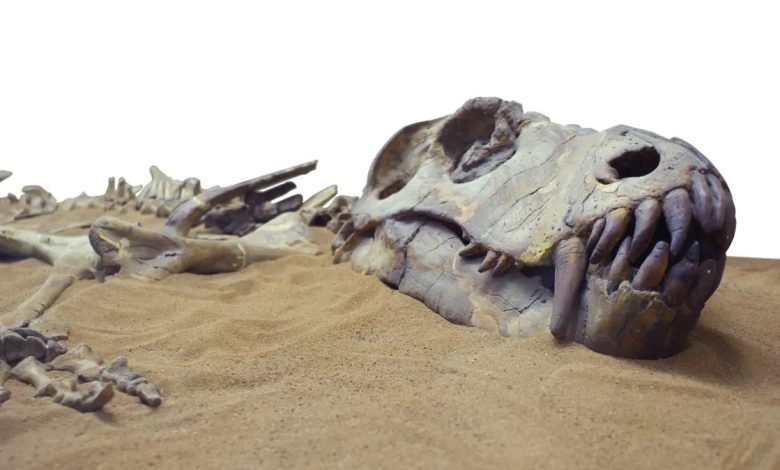The discovery of an extinct reptile that lived on dinosaurs 150 million years ago
In the real park of the Jurassic period, many dinosaurs are discovered. Far from science fiction movies, there is an area in the American West, specifically in Wyoming, where the Morrison Formation rocks dating back to the Upper Jurassic period (about 150 million years ago) extend.
The rocks of the Morrison Formation contain many dinosaurs, such as the herbivorous stegosaurus dinosaurs and the carnivorous Allosaurus dinosaurs, which has made researchers in that region focus on dinosaurs, regardless of what the rocks of the formation could carry from other small creatures that lived alongside these giant creatures. Fame and fame.
Matthew Carano - a specialist in paleobiology at the Smithsonian Museum of Natural History and lead author of the study - told "Science": Scientists are interested in collecting the treasures of the Morrison Formation of the largest and most dramatic dinosaurs, and overlook the diversity of small reptiles found there, perhaps due to the We only get small, incomplete and poorly preserved parts of it.
Matthew Carano is a paleontologist at the Smithsonian Museum of Natural History
Carano adds: In 2010, Peter Kroehler, one of the specialists in preparing specimens for the study, noticed the presence of two small bones inside a rock lying next to a dinosaur's nest. Hoping to find out what secrets she holds.
According to the press release, a copy of which was reviewed by Al-Alam, “After that, Joseph Gregor came to the museum as a volunteer to clean that sample and remove the rocks around it, and Gregor worked for months preparing the sample, using sharp tools with metal heads, and as soon as the bones appeared, until The scientists examined it under a microscope, and the sample was scanned in a CT scanner. Through the scan, the team obtained highly detailed images of the bones in three dimensions, allowing them to perform a near-complete reconstruction of the skull. After revealing the skeleton, it was a moment of astonishment for everyone. The team did not find a complete reptile skeleton in that period like this specimen, which made it extremely rare.”
At first, the researchers thought that the fossil belonged to a reptile that had been discovered before, especially since the work in that area is very old, more than a century and a half ago, but what was revealed by the micro-computed tomography was the most surprising and most important; It seemed to the researchers that the skeleton might be due to an entirely new species that had not been known before.
In the study, published in the Journal of Systematic Palaeontology, the researchers concluded that this structure is due to a type of beak-head reptile, and that it lived in the badlands of the Wyoming region.
The beaked reptiles (rhynchocephalians) are of great importance; They are cousins to snakes and lizards, and despite their numerous numbers, diversity of shapes and natures of feeding millions of years ago, only one species survives in New Zealand now, called tuatara.
Carano says: The tuatara reptiles, which are endemic to New Zealand and are the only extant beak-headed reptiles, have a deep historical story. Although it looks like a relatively simple lizard, it embodies an entire evolutionary saga dating back more than 200 million years.
And he continues: “Maybe the different species of beakerhead reptiles became extinct due to competition with lizards, or perhaps they became extinct due to global changes in climate and habitat change, and it is surprising that you have the dominance of one group giving way to another group to evolve over time, and I see that there is a need for more evidence To explain exactly what happened, but the lack of fossils is the drawback.
The researchers named the new species "Opisthiamimus gregori", after volunteer researcher Joseph Gregor, who spent hundreds of hours scraping the bones meticulously. The new reptile - from nose to tail - is about 16 cm long, and the shape of its teeth indicates that it is It was feeding on insects.
"The fossil has been added to the collections of the Smithsonian Museum of Natural History, so that it will remain available for future study," says Carano. This organism is the last living member of a group that has been almost completely replaced by lizards, and we may one day know the cause of the gap in spread and evolution between the survival of the tuatara reptile as the only reptile from His skin is built from beak-headed reptiles, compared to the spread of lizards so far all over the world.
Source: for information
https://shahbapress.net/archives/28307?fbclid=IwAR13Y5HL3Brf8k9iYsfZoSoLFlgW0JcF2cSBpN-L8krq095odHrpF_UqA1Y




